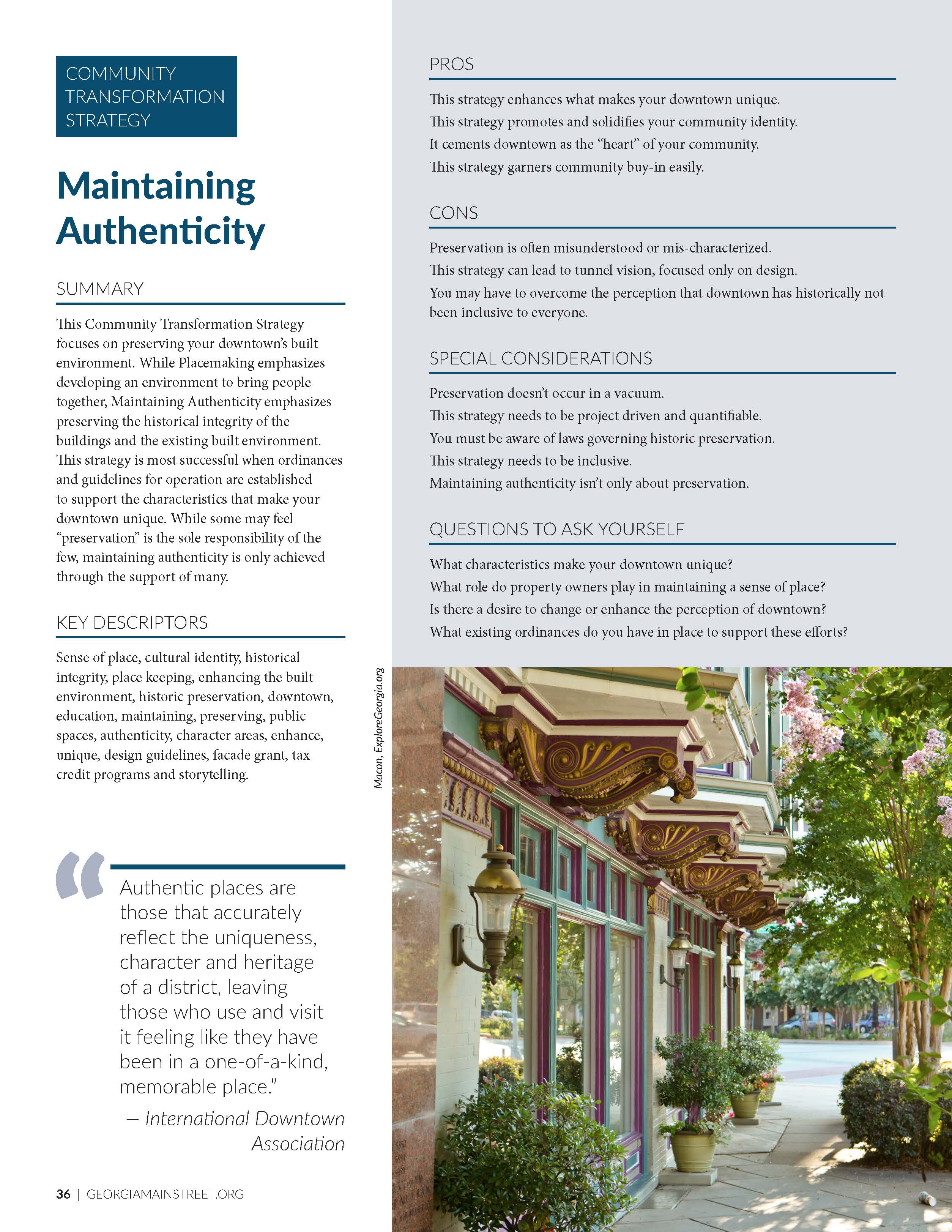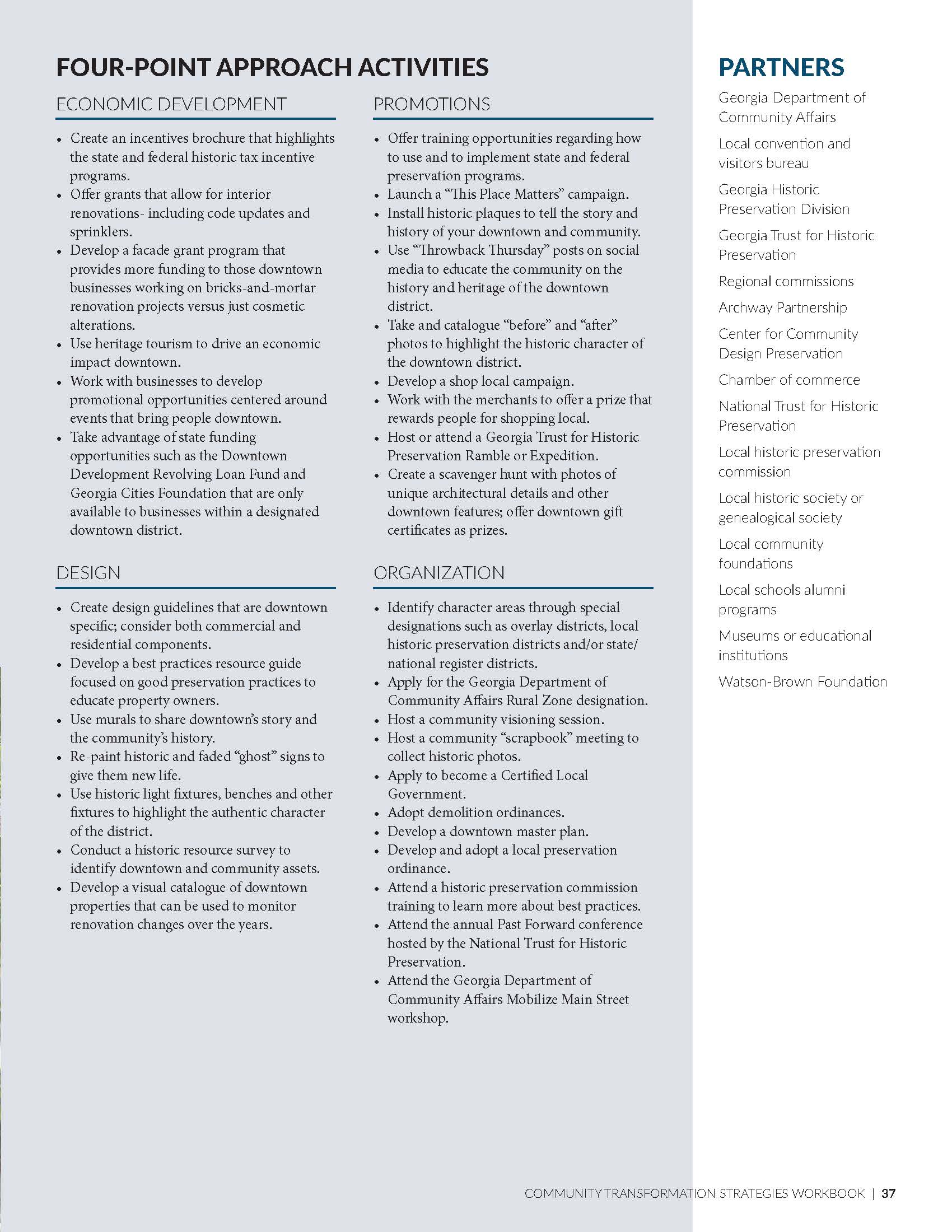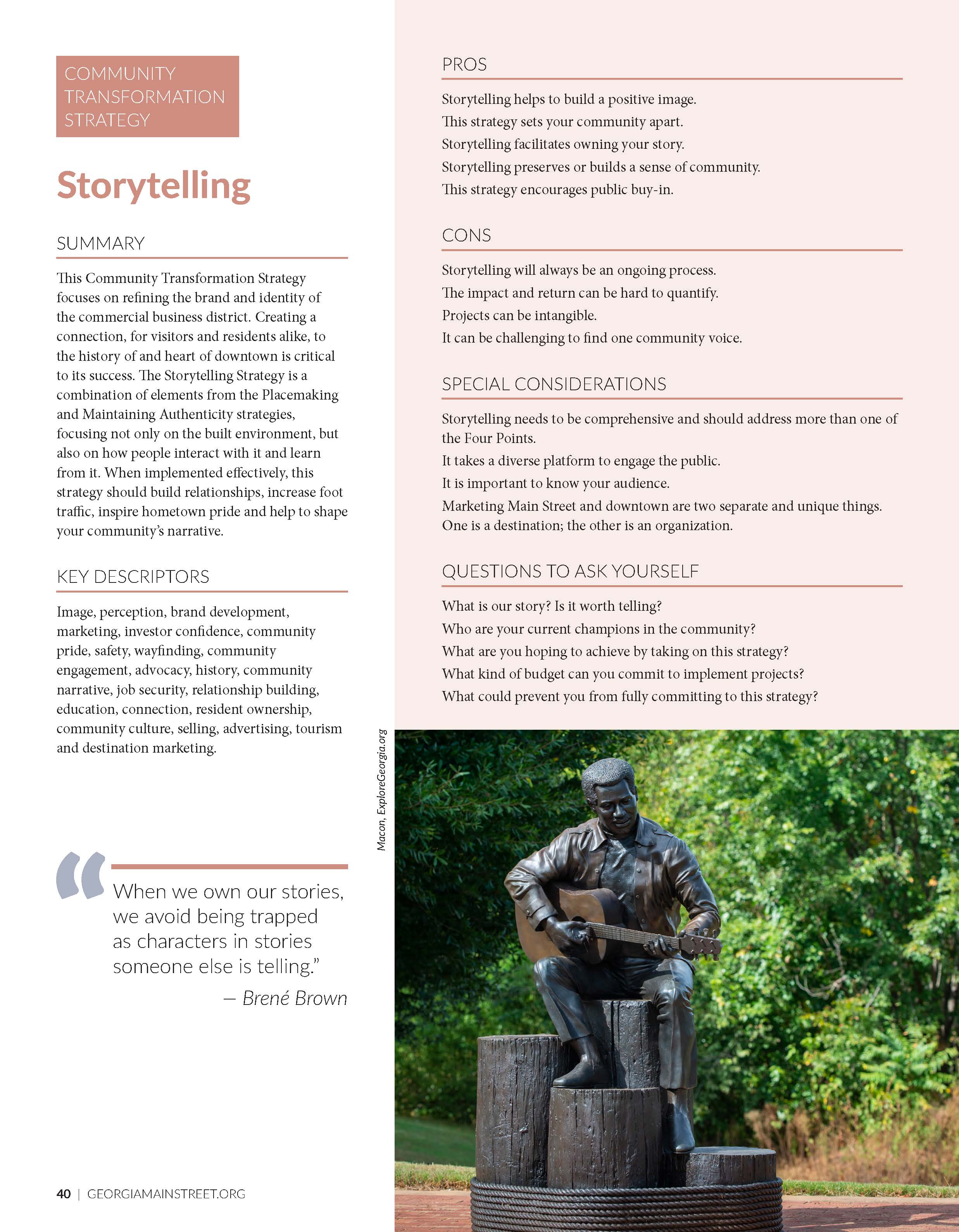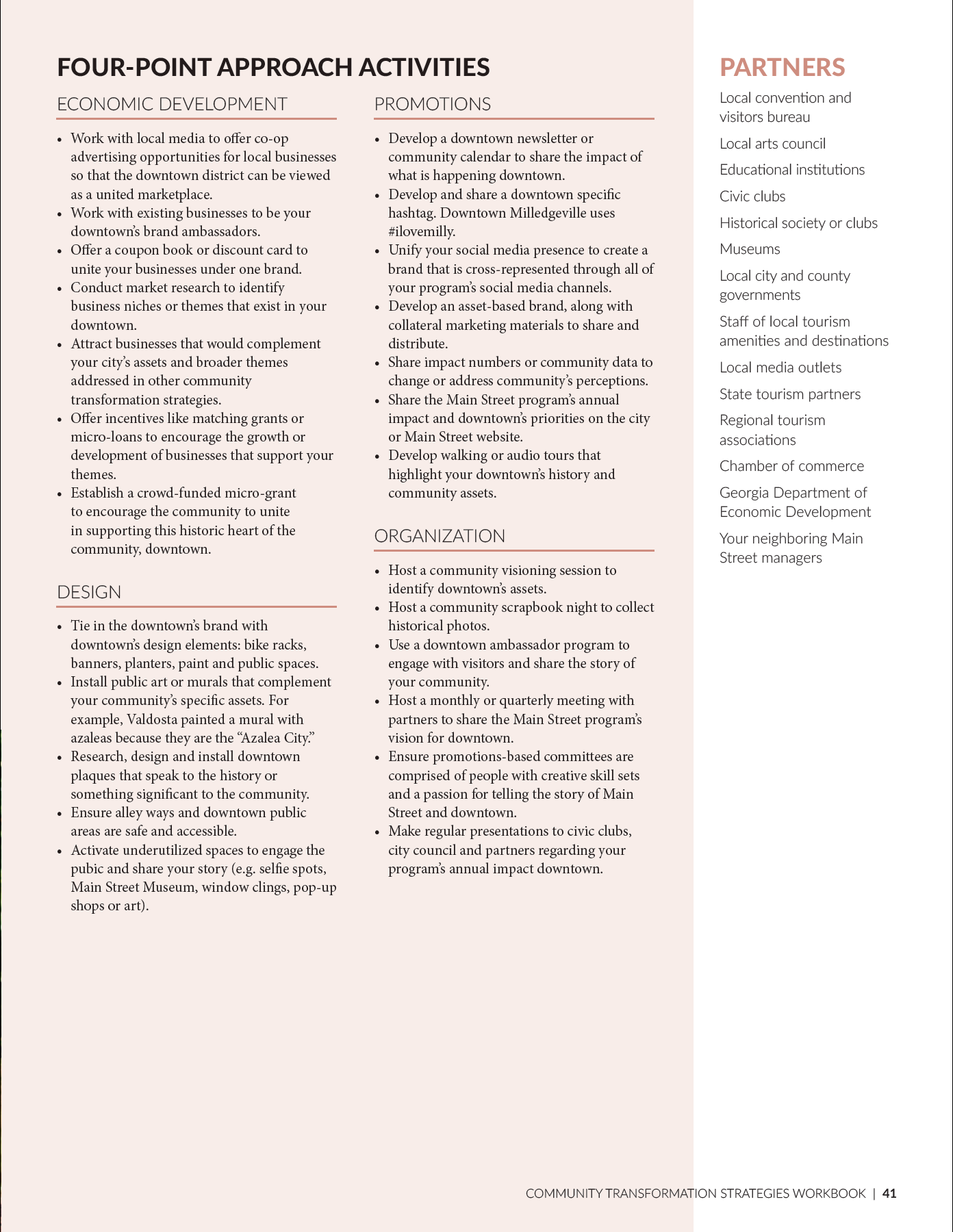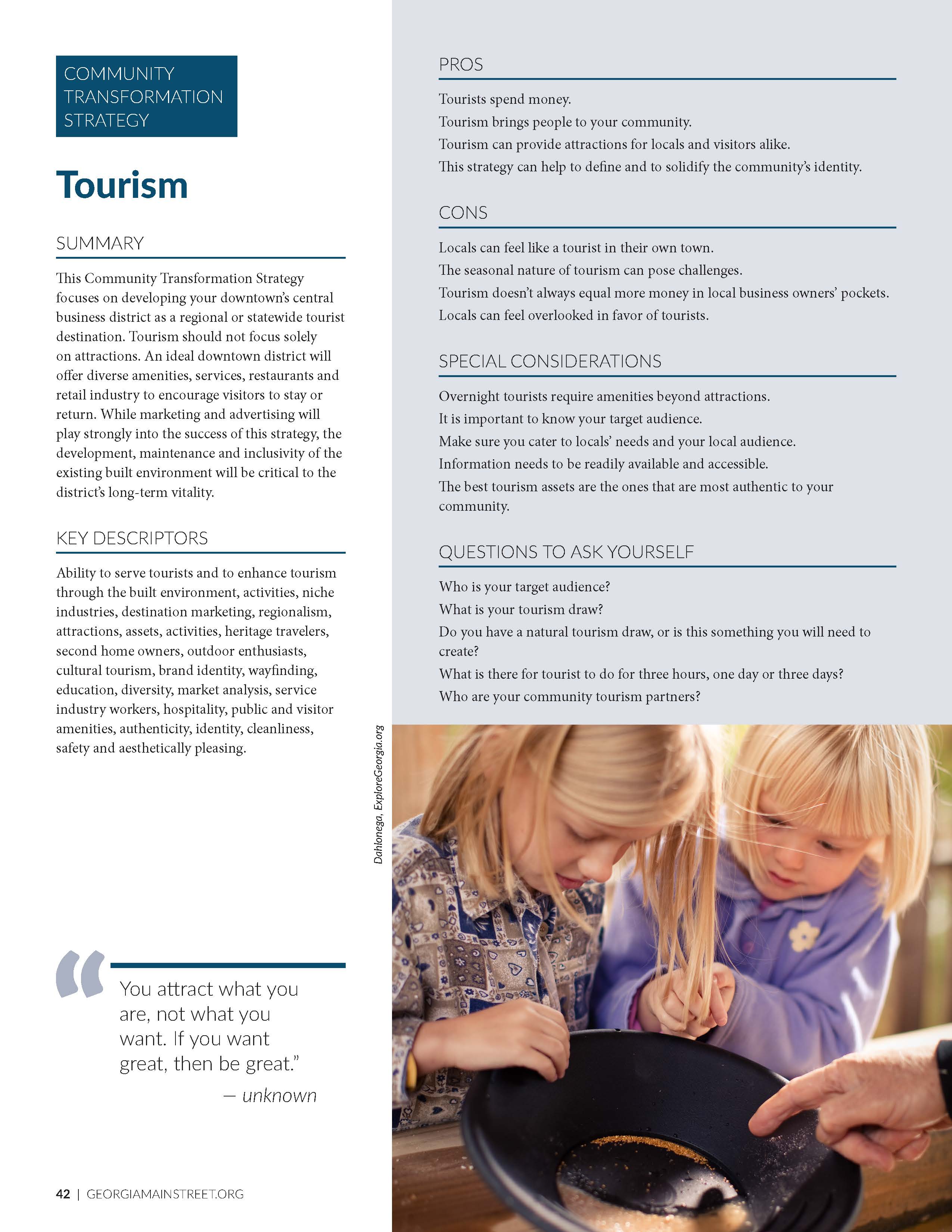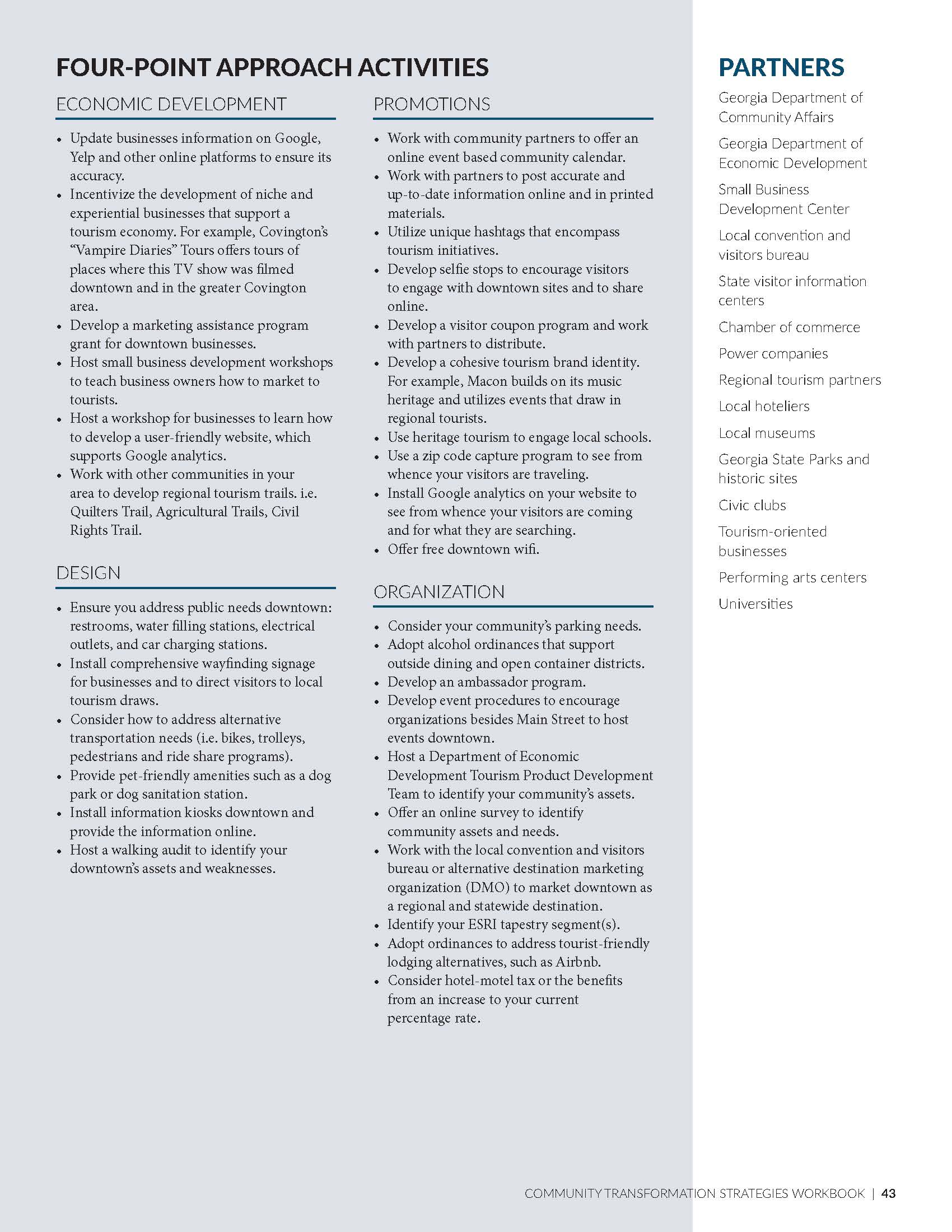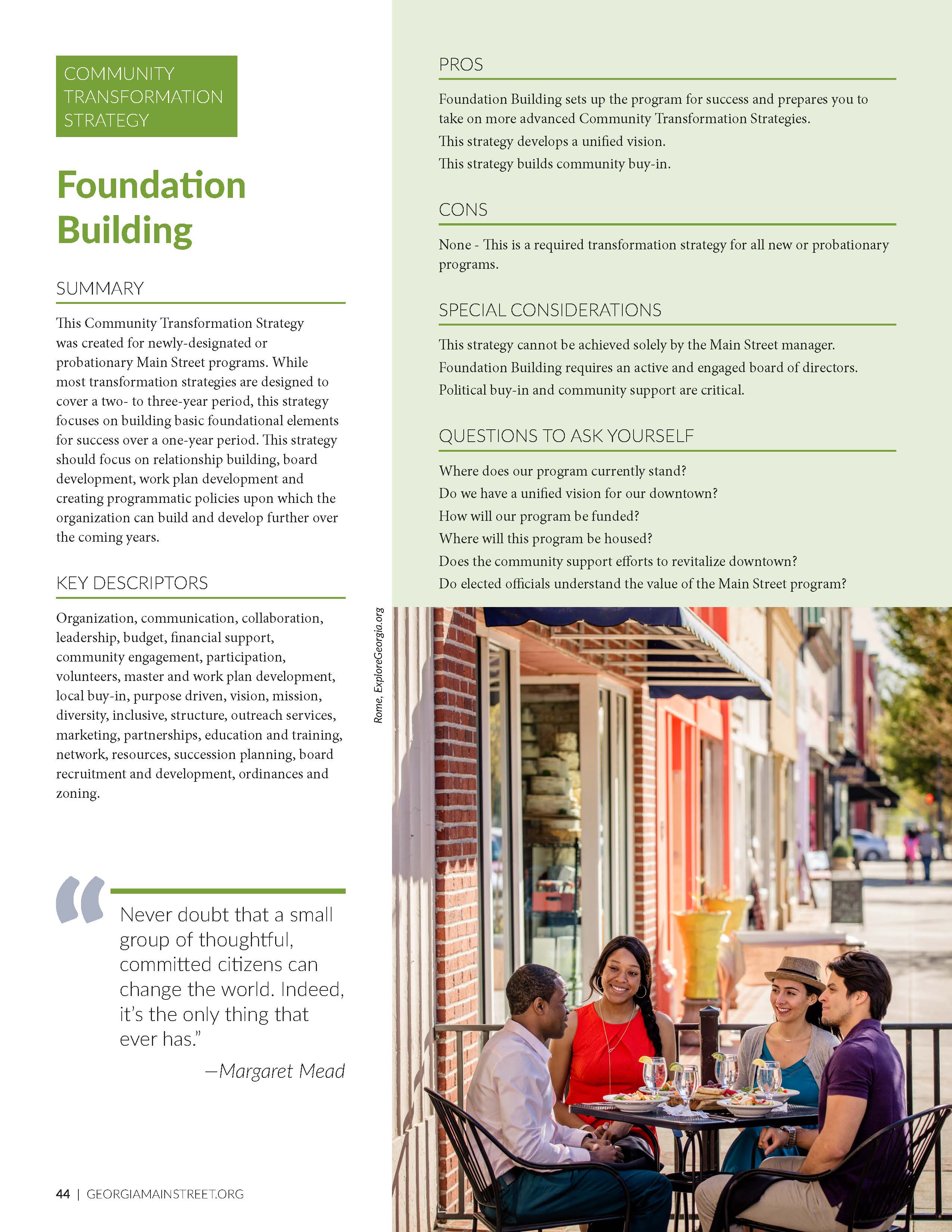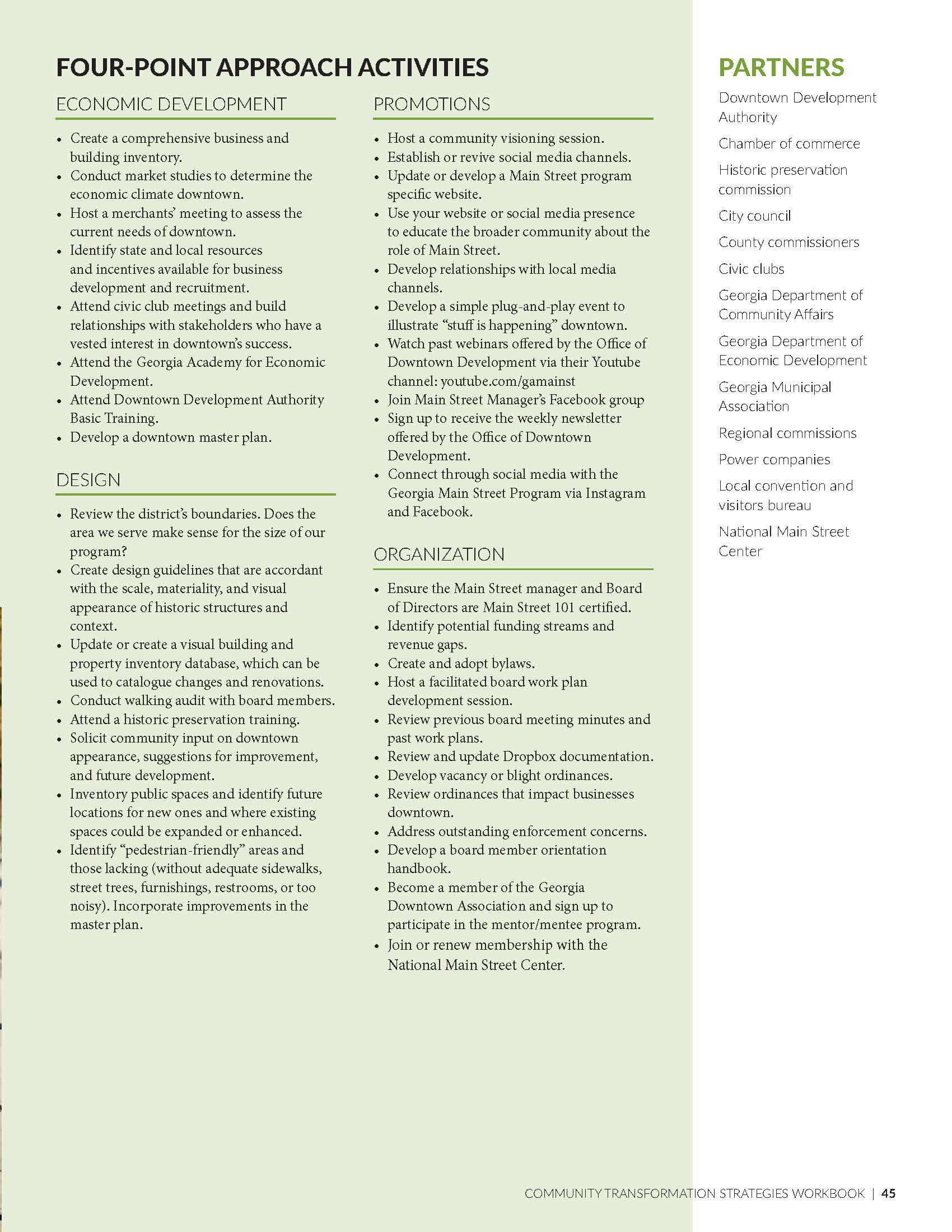Resources Library
News
Strategy #12- Maintaining Authenticity
The Office of Downtown Development requires all Classic and GEMS designated programs to use the provided Work Plan Template to document their programs Community Transformation Strategies and supporting goals/objectives. This document is built as an editable pdf but can be customized to fit the needs of the local Main Street program.
For more information we encourage you to check out our Work Plan Essentials webinar on YouTube:
Market analysis is a critical tool in helping decision makers assess the economic conditions of their commercial districts and arrive at an effective plan for transformation. This resource guide takes market analysis — a key component of the Main Street Approach — and breaks it down for practitioners.
This guide is intended to help Main Street directors and community leaders implement a people-centered design process. It explores the range of issues that impact the physical characteristics of a downtown and provides you with a roadmap for navigating the set of choices involved in implementing holistic design principles to ensure they complement the overall strategy for your downtown.
This guide will provide you with a practical framework for understanding how to launch or strengthen your community engagement efforts, and actionable tools to put to use in your own community. What follows is very much an overview; take advantage of the links to more information provided throughout and at the end. And be sure to read the National Main Street Center’s accompanying resource guides for support in turning the fruits of your community engagement process into actionable strategies for revitalizing your downtown or commercial district.
All Classic and GEMS designated Main Street programs are required to keep and maintain a Dropbox folder with all their program’s historical information. This Dropbox folder is set up by DCA and access is shared with the local Main Street manager, board members and key city staff as needed. Due to the volume of information maintained in these folder the Office of Downtown Development does require each program to adhere to a certain organizational structure within Dropbox for all files and supporting documentation. Attached you will find a link that will illustrate for you visually how your program’s Dropbox folder should appear along with a list of each item that should be visible within the individual sub-folders.
To request access to your program’s Dropbox folder please contact the Georgia Main Street team at mainstreet@dca.ga.gov

This is a simply formatted excel document that allows for Main Street Managers to track the training events and hours participated in by both the board and the manager, throughout year. Please also make sure to upload a copy of any supporting documentation such as certificates or awards to the “Standard 8” folder of the current year you are in.
The Board Roster template is an editable pdf that serves as a record of who in your Main Street community is currently serving as a member on your Main Street Board. This document is required to be updated annually and a copy of it should be uploaded to Dropbox under “Standard 5” of the current year. It is important to make sure that this document is filled out in it’s entirety to insure complete accuracy.
You can also access a copy of this document in excel Board Roster
Mission: What is Main Street Newnan?
Main Street Newnan is devoted to developing and maintaining a healthy, viable downtown commercial district symbolic of community caring, and the high quality of life available to residents and visitors alike.
Our perspective as an accredited National and Georgia Main Street Program is committed to historic preservation-based community revitalization. We facilitate this in practice by using the Main Street Four Point Approach, which considers these objectives. The promotion of our downtown district through special events and individualized marketing plans. The quality of the aesthetic design that is represented by our district’s built environment. The organization of interests, leadership and commitments that move our program forward, and the use of strategic planning to warrant the economic development of our historic commercial district. As a unique economic development tool, this approach provides our community with the opportunity to effectively stimulate our commercial downtown by leveraging: partnerships, our culture, small businesses, local assets, architectural heritage and community events to support local enterprises and community pride.
Our Vision: What is Main Street Newnan?
Downtown Newnan will continue to grow and develop as a result of continued support from our volunteers, local businesses, partnering organizations and our Sponsors, who all share a belief that a strong downtown is an essential component to the integrity of a community.
Collectively, we will continue to develop the balanced application of the Main Street Four-Point approach to enhance the future of our downtown district. As one of Georgia’s elder Main Street programs, Main Street Newnan has served as a liaison between the City of Newnan and the business community, local and regional economic development groups and the non-profit sector since 1986. Our inception as an accredited Main Street Program occurred 29 years ago by a group of local volunteers, businesses and partnering organizations, who invested countless hoursof personal time and financial resources to safeguard the fate of our downtown. Their commitment to preserve our city’s cultural identity through the redevelopment of our downtown district served as an example that continues to move our program forward into the future. Main Street Newnan understands that the retention of a successful revitalization program involves strategic partnerships. When considering the growth that Downtown Newnan has experienced, we hope to continue to develop and bolster the support that has been provided by our community. Main Street Newnan hopes to continue to see an increase in the amount of new program sponsors, as has been the trend for several years of growth. We also intend to sustain long lasting relationships with sponsors who have supported our program throughout many years, and even decades! We hope to continue to partner with new businesses and organizations, and experience an increase in volunteer participation by individuals. We will continue to guide and encourage existing downtown business owner to expand their portfolio, recruiting new businesses opening to Downtown Newnan. We will continue to use our resources to encourage property owners to invest in long lasting improvements, utilizing financial guidance and assistance from Main Street Newnan.
Click here to view this example on the Newnan Main Street Program’s website
Main Street Programs that choose to create their annual work plans around the Community Transformation Strategies will focus on a more broad based approach to downtown development. The enclosed Transformation Strategy Brief will help walk you through the steps needed to develop a work plan based around this approach.
To download a blank copy of our editable Community Transformation Strategies work plan please click here.
Why develop a board recruitment process?
While the task of recruiting board members might seem a little daunting, it’s important to take the time to find candidates with the right values, skills, attitude and commitment. After all, even though this is a volunteer job, being a board member is a crucial leadership role! These folks are going to be responsible for the financial and cultural well-being of your organization. They are defending and promoting your mission; acting as key spokespersons and possibly driving fund raising too. For small volunteer-led organizations, the board may be managing the day-to-day operations as well.
In going through a structured application and review process, you can take the time to really get to know the potential board members and lay the foundation for building a strong relationship. This is critical, since this new recruit will become a very active member of your immediate board family or team, which will be working together to lead the organization for one or two years. It’s not about filling seats. An established recruitment process (that includes a well-defined role and expectations as well as an application and screening process) ensures that all candidates are qualified and evaluated using consistent criteria and process. So, it won’t come down to a question of a referral gone wrong, an awkward situation or even worse, the desire to uninvite a candidate who turns out to be a bad fit or poses any potential conflicts of interest. Finally, this not a one-time exercise, you are building a long-term relationship. Although you might be thinking about filling a one-person gap right now, there will always be turnover of the board. So, it’s important to have a process in place rather than a stop-gap measure.
While you’ll want to revisit the specific criteria on a regular basis to ensure they suit your current needs, having a recruitment process in place takes the pressure off. And if your process includes maintaining on-going applications and leads, you may be able to jump right to the screening process when a board position comes available! So whether you are a staff person coordinating the recruitment process, a board member helping out in filling the gap on your board, or a member of the nominating or board development committee, it’s important to follow a recruitment process to ensure you identify, assess and choose the right candidate for this very important job.
4-step board recruitment process.
Who should manage the recruitment process? What we haven’t included in these four steps is an overview of who should manage the board recruitment process. In some small or newly established organizations, board members or committee members recommend or refer individuals for consideration by their board team or an executive committee. Other organizations create nominating or board development committees that manage the entire process. These committees are usually appointed by the board and include board members as well as other members of the organization to offer a mix of perspectives. The nominating committee is often chaired by a past board chair and may be a year-round standing committee or struck when there are board vacancies. Of course, the structure or membership of your board selection team or committee should be customized to suit your organization’s needs and may even be stipulated by your bylaws. The key is to have a group of individuals committed to taking the time to establish and follow a structured process.
Step 1: Define your needs
As Anne Wallestad, interim chief executive of Board Source suggests, “effective board service starts with the right match, the right match between an individual with the talent and commitment to make a difference and an organization that is in need of that individual’s unique blend of skills and attributes.” But how can you know a candidate is a good match unless you’ve identified what you are looking for? To ensure an effective, highly functioning board, you need to define the role and expectations for board members. This means defining the job, understanding the skills required to be successful in that job, and identifying the values and qualities that will enable the new recruit to become part of a cohesive board team. It’s also important to establish specific expectations for individuals and the board as a whole in order to set goals and evaluate performance.
Do you have a job description?
Just like the hiring process for a paid job, when you are recruiting board members, you start with a job description that outlines: the position’s key duties and responsibilities; the necessary requirements to fulfill those; and details on what the commitment entails. Here’s an outline of the type of information to include in your job or role description. You can use this as a guideline to draft a job description that meets your organization’s specific needs.
Benefits:
What benefits are involved with being a board member for your organization? (e.g., making a difference (how?); satisfaction in working with an energetic, committed board team, attending special events, etc.)
Responsibility and Authority:
– To whom is the board member accountable?
– What authority does each board member have?
What are the general responsibilities board members are expected to take on?
Term:
– How long are board members expected to serve?
– What are the conditions under which a board member can resign before the term is ended?
– What are the conditions under which a board member may be removed from the position? (this may be stipulated in your bylaws, so check wording)
General Duties:
What are the typical duties expected of a board member? (e.g., attends regular (monthly?) board meetings; reviews monthly financial statements; participates in fundraising; participates in/manages committees; etc.)
Are board members expected to manage or mentor the organization’s staff?
Time commitment:
Approximately what is the time commitment expected of board members? (e.g., number of hours for reviewing materials; attending board meetings; attending committee meetings, annual meeting, other tasks?)
Legal / Financial commitments:
– What are the legal implications of taking on this role? (e.g., liability; accountability?)
– What are the expectations in terms of bylaw development, monitoring, etc.?
– Are there financial expectations? (e.g., are board members expected to raise funds, provide sponsorships, etc?)
– What is the board member’s role in the organization’s finances? (e.g., is the board responsible for budget management? Is the board responsible for the organization’s financial health?)
Qualifications / Skills Requirements:
– What general skills are needed? (e.g., inter-personal, problem-solving and communications skills, etc.)
– What are some of the other skills or expertise you may be looking for? (e.g., board governance, policy development, financial expertise, strategic planning, marketing skills, event management experience, etc.)
– Are there specific skills or attributes you need right now?
Along with the specific job responsibilities, you need to think about the type of skills sets you need on the board, which skills are missing that are required to round out the board’s framework? It can be helpful to have a diverse board composition with members from different backgrounds and with different skills-sets that complement one another, like players on a sports team. In her Forbes article, Building Successful Non-profit Boards, Elmira Bayrasli suggests that there is real value to having different skills… individuals asked to join a non-profit board should bring added value to the institution and its staff. Because the majority of non-profits bootstrap their operations, taking care to minimize overhead, they often make do with a small staff that is expected to juggle several responsibilities, none of which few are experts in.
For example:
Do you need a change agent to help the board navigate?
Are you looking for someone with financial skills; fundraising, marketing or special events experience; human resources expertise?
Some organizations use a board composition matrix as a worksheet for detailing the skills, characteristics, and talents of your board members, and identifying gaps. But, as Peter Brinckerhoff reminds us, the skill set your board needs is a moving target. Some skills may be relatively timeless, but many change with the times. If you are planning a major building project, do you have bankers, architects and realtors on the board? If you are doing community outreach, what about community leaders, ministers, elected officials? His advice is to develop a short and long-term skill set list and drop it into your ongoing recruitment efforts. What qualities do new recruits need to bring to the boardroom table?
While skills are definitely important, when it comes to guiding your non-profits or association’s mission, looking at the fit for values and qualities is also essential. In her post, Recruiting for Board Members – Process? What Process? author Hildy Gottlieb offers some suggests of qualities that will help the board function better, do its job better.
Some examples may be:
– Understanding of our community and its needs.
– Passion for our cause.
– Willingness to commit time for board meetings, committee meetings, planning sessions, special events.
– Team player – works well in a group.
– Someone who listens well, is thoughtful in considering issues.
Step 2: Find candidates
The best-case scenario is to develop leads (e.g., through a nominating or board development committee) and maintain a list of potential candidates throughout the year. If your organization has a process in place to keep track of individuals who offer to volunteer throughout the year, you can simply pull that information and begin screening those candidates. However, if there is no pre-existing list or database of volunteers, you might want to develop a process for gathering and storing this information from here on in. This could involve creating a specific Board Application Form (see the section below), or a more general volunteer application form, online database or at the very least, a spreadsheet. While you may be lucky enough to have folks offering their service, in many cases, there is a perception that you need to be asked or invited to serve. So, if you don’t have any leads or list of board candidates, here are some ideas for finding new recruits.
Getting the word out:
The first step is letting folks know that you have an opening on your board. As we noted in our Getting Started with Volunteer Recruitment guide, there are a number of ways to get the message out, including:
Referrals and word-of-mouth:
The first place to start is with the standard request for referrals from existing board members and volunteers. Ask your existing team to look for candidates from among:
– Friends
– Family
– Colleagues and associates
– Neighbors
– Community members (at church; clubs; sporting teams, etc.)
– Publicize within your network:
– To identify candidates from a wider network, consider:
– Writing a newsletter article or a post on your organization’s blog or forum
– Posting a request on your Facebook page
– Posting a compelling video or photos of last year’s event on your FB page and ask for new recruits (follow-up with anyone that “Likes” your post)
Step 3: Screening and selection
Application form:
The application form (which can also be an online form) will help you gather and collect information about each applicant. Carter McNamara (Free Management Library) suggests that your application form include information such as: biographical information, why they want to join this board, what they hope to bring to the board, what they would like to get from their board membership and any questions they might have. He also offers a Sample Board Application Form, that your nomination committee can use as a guide in developing your own custom form. Although board members may refer or recruit colleagues or friends, it’s important that all candidates or prospects go through the full application and screening process to ensure consistency and to avoid any conflicts of interest or potential issues down the road. Screening/interview process:
Once you’ve reviewed the applications, you need to develop a process for screening potential candidates, so you can develop a short-list for interviews. As Hildy Gottlieb suggests, think of this application process as you would if you were hiring an employee. You want to get to know the applicant just as they want to get to know you, all to determine if there is a fit. Screening is an important step in this process and part of your due diligence work. Screening practices play a critical role for organizations in fulfilling their moral, legal, and ethical responsibilities to all those they reach, including members, clients, participants, employees, and volunteers.
The benefits of screening are threefold:
– To better match people’s skills and experience to the needs and opportunities in organizations;
– To improve the quality and safety of programs and services in communities;
– To reduce the risks and liability for both people and organizations.
Interview tips:
Holding an interview with all potential candidates offers an opportunity to discuss the role and find out about the candidates: background, skills, interests, qualifications, personal goals. And, generally, to see if he or she is a good fit for the role, the board team, and the organization as a whole.
In preparing for the interview consider:
– Developing a standard set of questions (these should include questions around: skills to meet job description; values and attitude; time commitment; potential conflicts of interest based on career or other volunteer activities; discussion of any legal and financial commitments, etc.)
– Start the interview with an overview of the selection process
– Provide an overview of the organization and its mission/objectives
– Go over the board role description (even if they’ve received it beforehand)
– Create a form to document responses consistently across all applicants.
Some organizations develop a short-list of candidates through the screening and interview process and actually invite them to attend a board meeting. Since the selection process may have only involved a few of the board members, this meeting offers an opportunity for the board to meet and interact with the candidates. It also lets the individuals see first-hand what a board meeting is all about.
Selection:
The final step in the screening process is for the nominating committee to choose the finalist from among the short-listed candidates. Again, the final selection should be made based on a set of criteria in terms of a skills-set fit, as well as a discussion of the candidate’s ability to fit with the board and the organization in terms of values, attitude and personality. Some organizations also require that screening of board candidates involves a police record check. Once the choice has been made, each of the candidates needs to be notified (preferably through a personal call from the chair of the nominating committee) to officially invite them to join the board, or else to thank them and let them know if their services aren’t required. If, however, any of the other short-listed candidates were considered a good fit, consider letting them know you’d like to call on them if there are any future openings on your board. Along with the call, the new board member should receive a letter confirming his/her invitation to join the board and outlining the role, timelines, commitment and all pertinent details.
Step 4: Provide an orientation for new board members
Congratulations, you’ve selected a new board member. But the process isn’t quite done yet, you need to orient the new member so they are ready to take on their new role. The orientation format can be done through providing a welcome package of information, an orientation video, a presentation or a training session, depending on your organization and its specific resources and needs.
However, at a minimum, new board recruits should receive the following information:
– An overview of the organization: its mission, vision, values
– Organization chart: outlining structure (e.g., board, committees, staff roles & responsibilities, etc.)
– Organization’s annual report and any other pertinent financial reports
– Role description (and any additional documentation or forms that need to be completed)
– The organization’s strategic plan
– Most recent board meeting minutes
– The organization’s most recent newsletter and/or brochure
– Schedule of board meetings (and locations), annual meetings and any other events he/she is required to attend
– Contact information: board chair, members, staff contacts etc.
In conclusion:
Board recruitment doesn’t have to be a challenging and urgent task to fill a gap. While you may have one seat open right now, there will always be turnover of the board, so it’s important to have a process in place rather than a stop-gap measure. While you’ll want to revisit the specific criteria on a regular basis to ensure they suit your current needs, having a recruitment process in place takes the pressure off. We hope this article helps you in getting started with or refreshing your board recruitment process.
It’s helpful to think of the Main Street Approach consisting of three tightly integrated components: community visioning and marketing understanding (the inputs), transformation strategies (implemented using the Four Points), and implementation and measurement (the outcomes).
1. Identify the Community Vision for Success
The Main Street Approach begins with creating a vision for success on Main Street that is rooted in a solid understanding of the market realities of the district, and is informed by broad community engagement. Main Street promotes a community-driven process that brings diverse stakeholders from all sectors together, inviting them to be proactive participants in the revitalization process. This essential step provides a foundation for outlining the community’s own identity, expectations, and ideals while confirming real and perceived perceptions, needs and opportunities. It also ensures that the vision is a true reflection of the diversity of the community.
2. Create Community Transformation Strategies
A vision of success alone is not enough. Communities must work together to identify key strategies, known asCommunity Transformation Strategies that will provide a clear sense of priorities and direction for the revitalization efforts. Typically communities will find two to three Community Transformation Strategies are needed to help reach a community vision. These strategies will focus on both long and short-term actions that will move a community closer to achieving its goals.
Work on these strategies would align with the four key areas Main Streets have been using as a guiding framework for over 35 years: Economic Vitality, Promotion, Design, and Organization, known collectively as the Main Street Four Points.
Economic Vitality
Revitalizing a downtown or neighborhood commercial district requires focusing on the underlying Economic Vitality of the district. This work is rooted in a commitment to making the most of a community’s unique sense of place and existing historic assets, harnessing local economic opportunity and creating a supportive business environment for small business owners and the growing scores of entrepreneurs, innovators, and localists alike. With the nation-wide growing interest in living downtown, supporting downtown housing is also a key element of building Economic Vitality.
Design
A focus on Design supports a community’s transformation by enhancing the physical elements of downtown while capitalizing on the unique assets that set the commercial district apart. Main Streets enhance their appeal to residents and visitors alike with attention to public space through the creation of pedestrian friendly streets, inclusion of public art in unexpected areas, visual merchandising, adaptive reuse of older and historic buildings, more efficiently-designed buildings, transit oriented development, and much more.
Promotion
Promoting Main Street takes many forms, but the ultimate goal is to position the downtown or commercial district as the center of the community and the hub of economic activity, while creating a positive image that showcases a community’s unique characteristics. This can be done through highlighting cultural traditions, celebrating and preserving important architecture and history, encouraging local businesses to market cooperatively, offering coordinated specials and sales, and hosting special events aimed at changing perceptions of the district and communicating to residents, investors, businesses, and property-owners that this place is special.
Organization
A strong organizational foundation is key for a sustainable Main Street revitalization effort. This can take many forms, from a standalone non-profit organization, to a special assessment district, to a program housed in a municipality or existing community development entity. Regardless of the organizational type, the focus is on ensuring that all organizational resources (partners, funding, volunteers, etc.) are mobilized to effectively implement the Community Transformative Strategies.
3. Impact and Measurement
To succeed, Main Street must show visible results that can only come from completing projects – both shorter and longer-term activities that add up to meaningful change. Activities aligned with shorter-term strategies focus on highly visible changes that are a reminder that the revitalization effort is under way and succeeding, helping to secure buy-in from community members and rallying volunteers. Placemaking strategies – those actions which focus on what can be achieved “lighter, quicker, and cheaper” are particularly effective and important in energizing the community and demonstrating short-term progress.
While shorter-term, highly visible activities are critical to Main Street’s success, communities must also sustain focus on implementation of longer-term projects and activities that are the building blocks for substantial change over time. Identifying milestones for these longer-term projects can be important in creating a sense of forward momentum and reinforcing to the community the need for sustained focus on revitalization efforts.
Coinciding with implementation is an equally important focus on measuring progress and results. Healthy Main Streets are built on a commitment to measure outcomes. We live in a time where public resources are scarce, and competition for private resources is fierce. Main Streets must be able to demonstrate the wise use of resources, which translates to real change on the ground: new jobs added to a Main Street, new businesses open, buildings redeveloped, and numerous other metrics of success. The National Main Street Center, together with our network of over 45 Main Street Coordinating Partners, works to make measuring results on Main Street easier and accurate.
| Mission Statement | Vision Statement | |
| About: | A Mission statement talks about HOW you will get to where you want to be. Defines the purpose and primary objectives. | A Vision statement outlines where you want to be. Communicates both the purpose and values of your business |
| Answer: | It answers the question, “What do we do?” | It answers the question, “Why are we here?” |
| Time: | A mission statement talks about the present leading to its future. | A vision statement talks about your future. |
| Function: | It lists the broad goals for which the organization is formed. Its prime function is internal, to define the key measure or measures of the organization’s success and its prime audience is the leadership team and stockholders. | It lists where you see yourself some years from now. It inspires you to give your best. It shapes your understanding of why are you working here |
| Change: | Your mission statement may change, but it should still tie back to your core values and vision. | Your vision should remain intact, even if the market changes dramatically, because it speaks to what you represent, not just what you do. |
| Developing a statement: | What do we do today? For whom do we do it? What is the benefit? | What do we want to do going forward? When do we want to do it? How do we want to do it? |
| For what business?: | For an established business | For a new start up business, new program or plan |
| Features of an effective: | Purpose and values of the organization Which business the organization wants to be in (products or services, market) or who are the organization’s primary “clients” (stakeholders) Which are the responsibilities of the organization towards the | Clarity and lack of ambiguity Paint a vivid and clear picture, not ambiguous Describing a bright future (hope) Memorable and engaging expression Realistic aspirations, achievable Alignment with organizational values and culture |
| For new and small firms: | should be a concise statement of business strategy and developed from the customer’s perspective and it should fit with the vision for the business. | spells out goals at a high level and should coincide with the founder’s goals for the business. |

